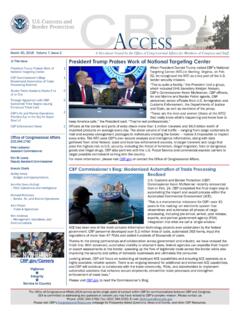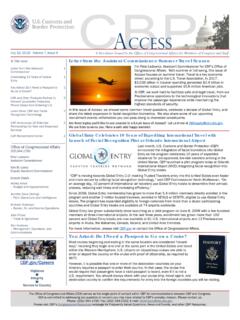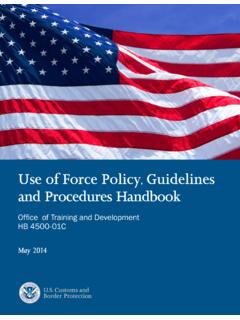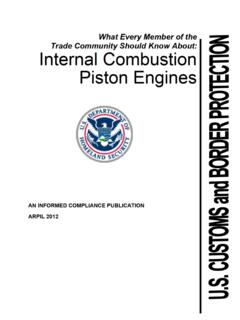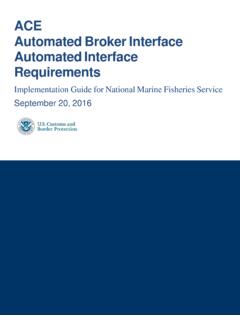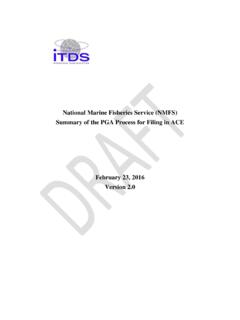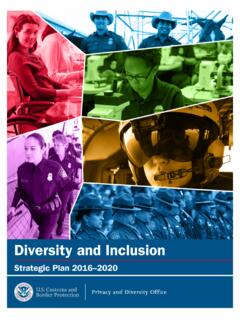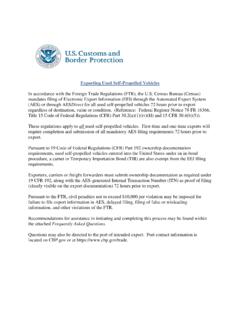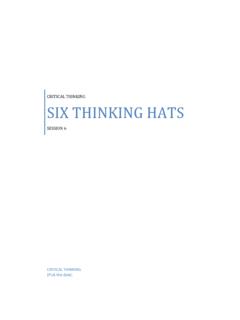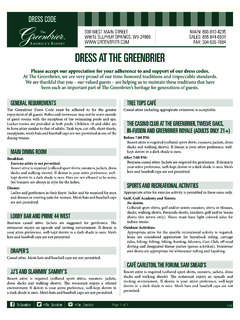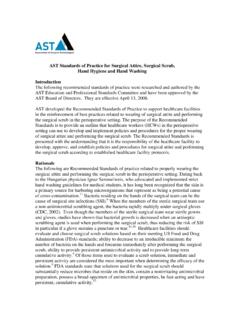Transcription of ICP - Hats and Other Headgear
1 What Every Member of the Trade Community Should Know About: Classification of hats and Other Headgear under HTSUS Heading 6505 AN INFORMED COMPLIANCE PUBLICATION JUNE 2008 2 hats and Other Headgear June 2008 NOTICE: This publication is intended to provide guidance and information to the trade community. It reflects the position on or interpretation of the applicable laws or regulations by Customs and Border Protection (CBP) as of the date of publication, which is shown on the front cover. It does not in any way replace or supersede those laws or regulations. Only the latest official version of the laws or regulations is authoritative. Publication History First Issued March 1999 Revised January 2004 Revised May 2005 Reviewed with No Changes June 2006 Revised June 2008 PRINTING NOTE: This publication was designed for electronic distribution via the CBP website ( ) and is being distributed in a variety of formats.
2 It was originally set up in Microsoft Word97 . Pagination and margins in downloaded versions may vary depending upon which word processor or printer you use. If you wish to maintain the original settings, you may wish to download the .pdf version, which can then be printed using the freely available Adobe Acrobat Reader . hats and Other Headgear June 2008 PREFACE On December 8, 1993, Title VI of the North American Free Trade Agreement Implementation Act (Pub. L. 103-182, 107 Stat. 2057), also known as the Customs Modernization or Mod Act, became effective. These provisions amended many sections of the Tariff Act of 1930 and related laws. Two new concepts that emerge from the Mod Act are informed compliance and shared responsibility, which are premised on the idea that in order to maximize voluntary compliance with laws and regulations of Customs and Border Protection, the trade community needs to be clearly and completely informed of its legal obligations.
3 Accordingly, the Mod Act imposes a greater obligation on CBP to provide the public with improved information concerning the trade community's rights and responsibilities under customs regulations and related laws. In addition, both the trade and Customs and Border Protection share responsibility for carrying out these requirements. For example, under Section 484 of the Tariff Act, as amended (19 1484), the importer of record is responsible for using reasonable care to enter, classify and determine the value of imported merchandise and to provide any Other information necessary to enable Customs and Border Protection to properly assess duties, collect accurate statistics, and determine whether Other applicable legal requirements, if any, have been met. CBP is then responsible for fixing the final classification and value of the merchandise.
4 An importer of record s failure to exercise reasonable care could delay release of the merchandise and, in some cases, could result in the imposition of penalties. Regulations and Rulings (RR) of the Office of International Trade has been given a major role in meeting the informed compliance responsibilities of Customs and Border Protection. In order to provide information to the public, CBP has issued a series of informed compliance publications on new or revised requirements, regulations or procedures, and a variety of classification and valuation issues. This publication, prepared by the National Commodity Specialist Division of Regulations and Rulings is entitled "Classification of hats and Other Headgear under HTSUS Heading 6505. It provides guidance regarding the classification of these items.
5 We sincerely hope that this material, together with seminars and increased access to rulings of Customs and Border Protection, will help the trade community to improve voluntary compliance with customs laws and to understand the relevant administrative processes. The material in this publication is provided for general information purposes only. Because many complicated factors can be involved in customs issues, an importer may wish to obtain a ruling under Regulations of Customs and Border Protection, 19 Part 177, or to obtain advice from an expert who specializes in customs matters, for example, a licensed customs broker, attorney or consultant. Comments and suggestions are welcomed and should be addressed to the Executive Director, Regulations and Rulings, Office of International Trade, Customs and Border Protection, 1300 Pennsylvania Avenue, NW, (Mint Annex), Washington, 20229.
6 Sandra L. Bell Executive Director, Regulations and Rulings Office of International Trade 3 hats and Other Headgear June 2008 (This page intentionally left blank) 4 hats and Other Headgear June 2008 7 HEADING 7 HAIR-NETS .. 9 9 hats AND Other Headgear OF COTTON, FLAX OR BOTH .. 9 hats AND Other Headgear OF 9 hats AND Other Headgear OF MAN-MADE FIBERS .. 10 WHOLLY OR IN PART OF 10 Braid Serves a Useful Purpose .. 11 Braid Affects the Nature of the Article .. 12 Other hats AND Other Headgear .. 13 NOVELTY 13 THE IMPORTER S RESPONSIBILITIES .. 15 INVOICING REQUIREMENTS .. 16 ADDITIONAL 17 The Internet .. 17 Customs Regulations .. 17 Customs 17 Importing into the United States .. 18 Informed Compliance Publications .. 18 Value 19 Your Comments are Important .. 20 5 hats and Other Headgear June 2008 (This page intentionally left blank) 6 hats and Other Headgear June 2008 INTRODUCTION The purpose of this Informed Compliance publication is to advise importers, customs brokers and others of the various issues affecting the importation and tariff classification of hats and Other Headgear under heading 6505, HTSUS.
7 HEADING 6505 Heading 6505 of the HTSUS provides for hats and Other Headgear , knitted or crocheted, or made up from lace, felt or Other textile fabric, in the piece (but not in strips), whether or not lined or trimmed; hair-nets of any material, whether or not lined or trimmed. This heading includes six-digit subheadings for Hair-nets (subheading ) and Other (subheading ). The six-digit subheading is divided by component material and construction of the material into eight-digit subheadings. Of cotton, flax or both is covered by through ; Of wool is covered by through ; Of man-made fibers is covered by through ; and Other is covered by 1 The Explanatory Notes (EN) to the Harmonized Commodity Description and Coding System are published by the World Customs Organization (Customs Cooperation Council).
8 Although not legally binding, they represent the official interpretation of the tariff at the international level. The EN to , page 968, state that: This heading covers hats and Headgear (whether or not lined or trimmed) made directly by knitting or crocheting (whether or not fulled or felted), or made up from lace, felt or Other textile fabric in the piece, whether or not the fabric has been oiled, waxed, rubberized or otherwise impregnated or coated. This means that under this heading knit or crocheted hats and Headgear can be made of any material; if not knitted or crocheted they must be of textile fabric. The heading includes hat-shapes made by sewing but not hat-shapes or Headgear made by sewing or otherwise assembling plaits or strips (heading ).
9 (See the EN to and for a good explanation regarding this exclusion). The EN to , state the heading includes: 1 Explanatory Notes 1996 Customs Co-operation Council (formal name of the World Customs Organization). The Explanatory Notes are available in printed and electronic versions from commercial sources or The World Customs Organization, Espace Nord, rue du March 30, B1210 Brussels, Belgium 7 hats and Other Headgear June 2008 (1) hats , whether or not trimmed with ribbons, hat pins, buckles, artificial flowers, foliage or fruit, feathers or Other trimmings of any material. Headgear of feathers or artificial flowers is excluded (heading ). (2) Berets ( Other than those made directly from felt plateaux - heading ), bonnets, skull-caps and the like.
10 These are usually made directly by knitting or crocheting, and are frequently fulled ( , basque berets). (3) Certain oriental Headgear ( , fezzes). These are usually made directly by knitting or crocheting, and are frequently fulled. (4) Peaked caps of various kinds (uniform caps, etc.). (5) Professional and ecclesiastical Headgear (mitres, birettas, mortar-boards, etc.). (6) Headgear made up from woven fabric, lace, net fabric, etc., such as chefs hats , nuns head-dresses, nurses or waitresses caps, etc., having clearly the character of Headgear . (7) Cork or pith helmets, covered with textile fabric. (8) Sou westers. (9) Hoods. Detachable hoods for capes, cloaks, etc., presented with the garments to which they belong, are, however, excluded and are classified with the garments according to their constituent materials.
